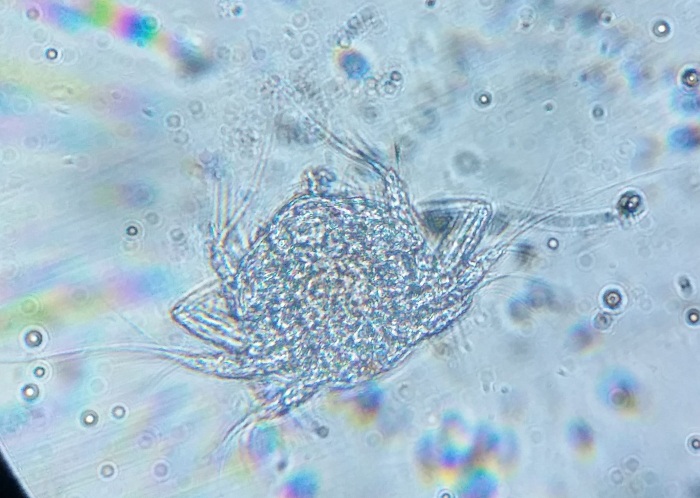
When I am done with one of my samples, I usually seal it off, and store it. I always assumed that these samples are dead shortly after, having no source of fresh air or sunlight to support photosynthesis. I have been very wrong.

When I am done with one of my samples, I usually seal it off, and store it. I always assumed that these samples are dead shortly after, having no source of fresh air or sunlight to support photosynthesis. I have been very wrong.
From what I have read, and begun to discover, the real visual prize of the microbial world involves the diatoms. Now that the waters are warming, I’m having an easier time finding these little, be-glassed critters.
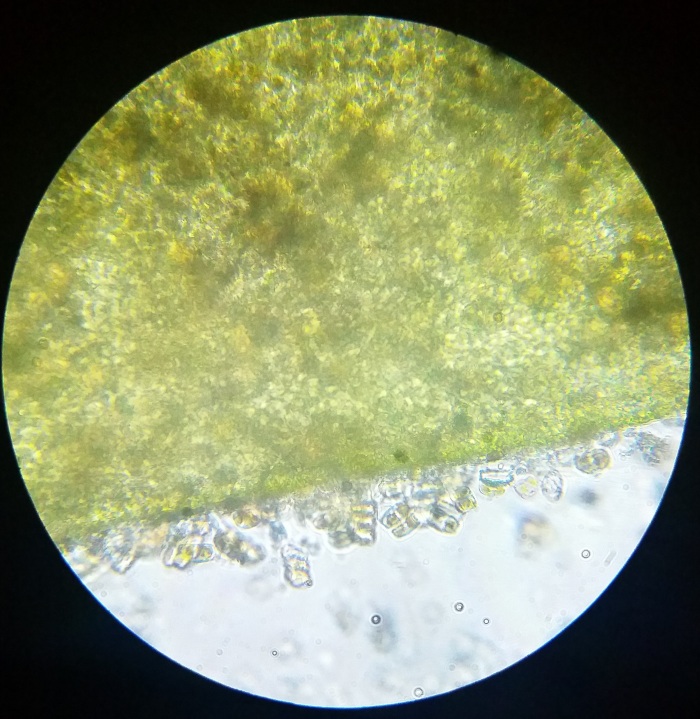
It was through my father’s work that I first realized I had a love for textures. For the entire time that I knew him, he had a fascination with everything about surfaces and the textures that occupied them.
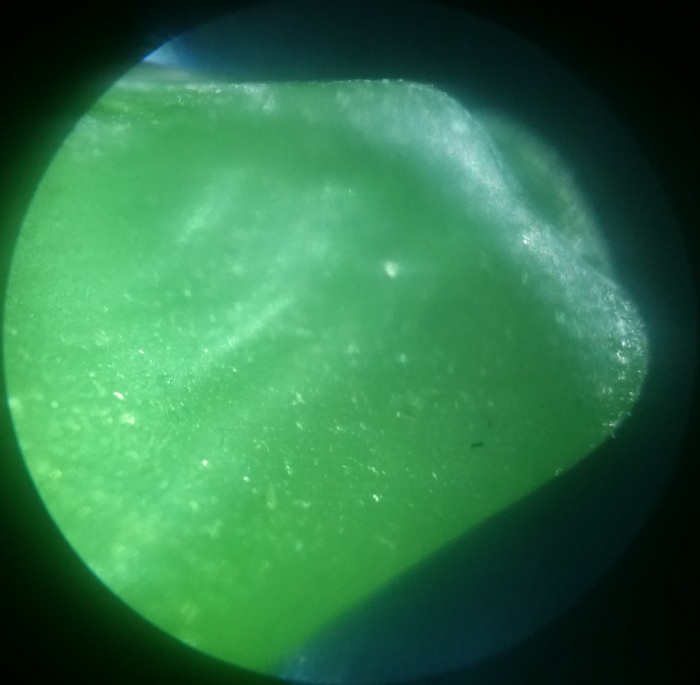
I have been wanting to put glass under the microscope for a long time now. The result was interesting, but not what I was expecting. Above is the edge of a narrow piece of green sea-glass.
Thicker objects offer difficulties when using the microscope. Essentially, they do not lie as easily flat, and you get a washing out of the image. I think with some different camera settings, I might be able to adjust for this problem. Additionally, you can only focus on one layer of an object at a time.
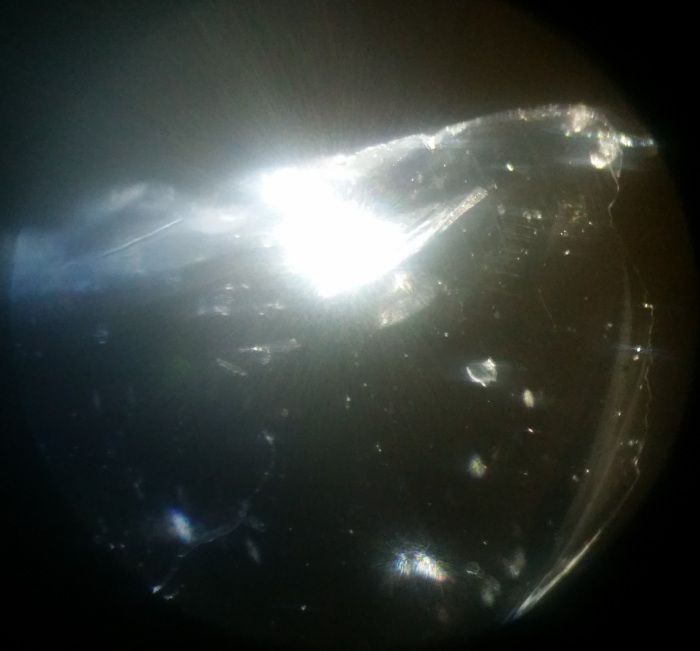
Here is a chip of glass at 100x magnification. Even at this magnification, it looks pretty sharp. But you can also begin to see it’s width in this picture.
Sand: Nature’s Glass
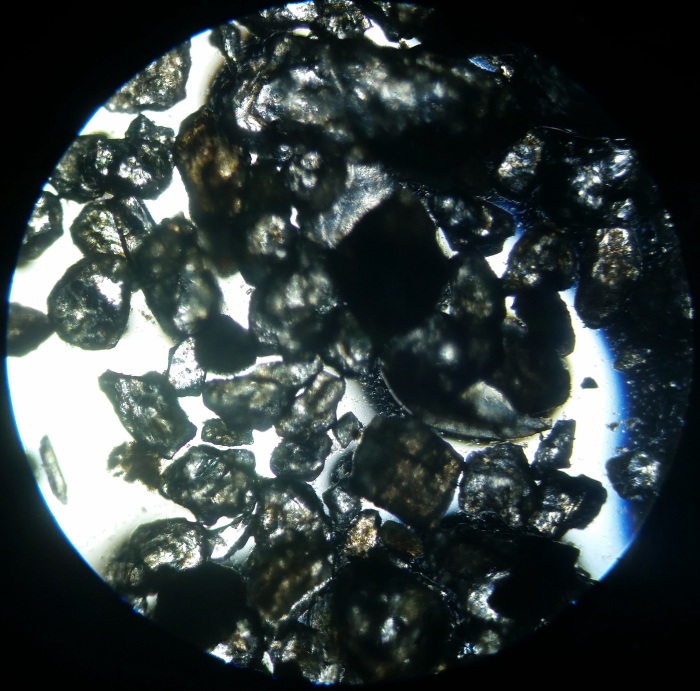
Sand at 10x, and you can already see the sharp edges.
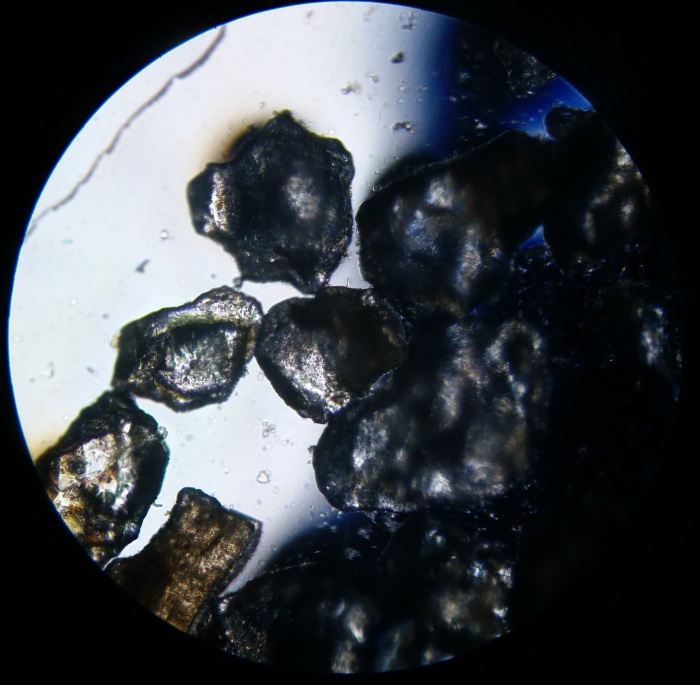
Here it is at 100x. You can see that there is a shape to the individual sand particles, an almost natural faceting that occurs.
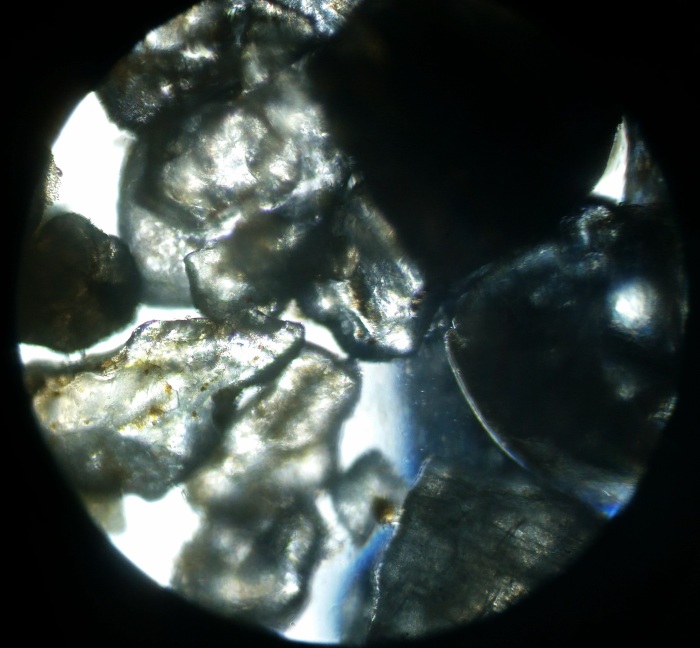
This is my favorite shot that I got that day. You can see the little spear tip of some of the grains, a perfect expression of how they stick your skin.
Next time, some interesting textures I’ve collected.
To me, this looks like microscopic bamboo. I have always loved bamboo for its aesthetic beauty and extreme utility. So I was excited to find this tiny analog.
I am fairly certain that each rectangle is one cell. That means this plant is one cell wide but many cells long. You can see the green spots inside each cell. This is the site of photosynthesis.
I have referred to the green spots as chlorophyll before, and that is somewhat true. Each green sphere is called a chloroplast. These are plasmids that contain chlorophyll. I was close enough.
Here are some other tiny plants:
It has tiny branches!
All roads lead to…whatever that brown thing is.
I have no clue what this is. It sort of looks like a decapitated bug head with pinchers. Maybe they are roots.
The flower of my find is sort of like a flower even:
Here it is from far away…just a cluster of green. Up close, however…
This plant has little bell shaped leaves stuffed with chloroplasts.
I am often fascinated by the endless textures you can find. I intend to do a whole post about textures. Here is one I found in the same sample.
It is some sort of woody plant cluster. Take a closer look.
Either that’s a bark like plant casing or some sort of egg cluster. Either way I find it to be beautiful.
Thanks for sharing in my finds. I hope to get great samples as the water warms and microorganisms can flourish.
When I was messing around with my microscope late last fall, I was looking for life in all the wrong places. I assumed if I just grabbed any old water, it would be loaded with tiny critters (yes, I use the term critters a lot when talking about this stuff, and I’m not likely to stop any time soon). I would take a few empty vials to the nearby shoreline and grab some samples, come home, and find nothing at all.
I’ve since learned that the majority of plankton (tiny ocean critters including micro-animals, and micro-plants) do not live during the winter. Furthermore, if there isn’t any vegetation in the sample, you probably won’t find jack.
Well, it’s spring, and I’ve learned quite a bit since then. This time I was in search of the famous diatom. Diatoms are little, single-celled phytoplankton (plant-based plankton), and they are also quite beautiful. Their distinguishing feature is their glass shell, which they construct from silica that they harvest from the ocean.
Here is one that I found, it’s the long double pointed critter towards the bottom of the screen:
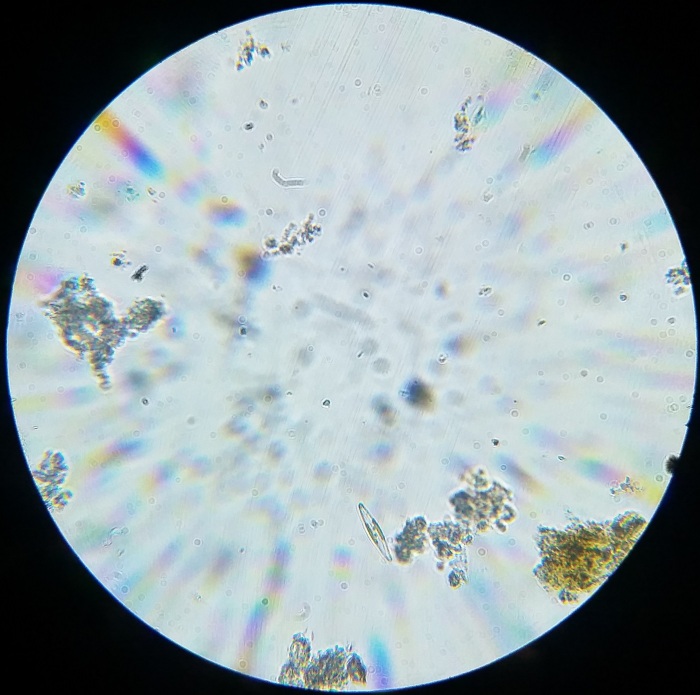
Diatoms come in thousands of forms, but they are easy to identify because of their symmetry. I believe that this one is of the genus Navicula.
I often wonder about their little glass shells, because, as you might imagine, it’s designed to protect them from predators. Except, it doesn’t. Diatoms, along with their plankton mates, make up the primary source of food in the ocean. You couldn’t count the virtually unlimited number of these little guys that get eaten every day.
Some diatoms have an additional defense. They contain a trace of toxic acid known as domoic acid. Eat just a few, and whatever, no problem. Eat a few hundred thousand, and you just might start to feel a little queasy. Of course, humans don’t really eat diatoms on the hundreds of thousands scale. But they do eat creatures that eat them in the hundreds of thousands.
What kind of defense is that anyway? Oh, you may eat me, and you might eat my brother, and my cousins, and my distant relatives, and all of the members of my town, and the neighboring towns…and you’ll be fine. But eat a few cities of us, and bam, you might get a mild headache. Of course, like all poison, if you eat enough of it, it can cause some serious complications, and probably kill you.
How can you tell if the seafood you ate had some domoic acid? You can’t. Enjoy your next trip to the seafood restaurant!
I managed to grab a few videos of this little diatom, and I spliced them together. I hope you enjoy it!
The whole process of collecting samples and examining them for fun life forms has become somewhat addictive. I’m doing my best to research what I find, and see if I can identify them by genus. I have a backlog of images and videos already, and am cranking out these posts as fast as I can to catch up.
I’ve also created a very cheap rig for attaching my phone to the microscope, so I don’t have to hold it up the whole time. I’d like to thank my friends rubber bands and cardboard.
Additionally, I’m running into an issue with my 40x lens, I believe it is scratched. I’m going to have get a new one. Until then, all of my 400x images will have a bunch of visual noise in them.
Insects can be some of the more upsetting creatures, especially under magnification. They can also be some of the most interesting. I found this creature in the same sample as the water bear (a sample I finally had to free to the universe/garden just last night).
Check out this little guy:
At first I thought it had six legs (and was therefore a real insect), and appeared to be a beetle. This is at 400x, so it’s very tiny. The only creature I could find that matches that description and size was the Scydosella. However, I slowed down the video, and at a few moments you can see that it has 4 legs on each side, and is therefore no bug. It is an arachnid. And to be specific, I think it’s a mite. These things can be tough to identify.
A paramecium walks into a bar, and the bartender says “You can’t come in here, we don’t serve your kind here.” The paramecium responds by splitting into two. And then into four, then eight, and so on. The bartender couldn’t afford to miss out on that kind of business growth, so he let him(they) stay.
Here is one that I found in that same moss sample as the water bear:
Even though he can swim anywhere, he chooses to stay put and move his insides about. It’s probably subconscious.
I’ve found a few rotifers. Here is a video of one that I found. It’s just mucking about. Notice how when it extends, it bears a slight resemblance to the water bear. That is why I accidentally mistook the first one of these I saw as a water bear. But if you look closely, it doesn’t have 8 legs. It does seem to have a rear set of grasping legs. So that’s something.
I found another rotifer, and I thought it was dead. Then I zoomed in, and noticed that it was digesting food. See the green swirling matter? That’s mushed up plants it has ingested. If you wait until the end of the video, you can see a great swirling of plant matter in it’s belly. I wonder if that makes it feel the way I do when my stomach is mad at me for eating something stupid?
Next time I’m going to show you some pictures of what I have found so far in a sea water sample, including a nifty diatom, and some really cool tiny plants.
This time of year, the ants get enough energy in them to get creative. They start repopulating their wasted, winterized nests, and pour forth the ground to find whatever resources they need.
Apparently, some ants found a resource by my bed. This is a great mystery, as I do not eat in bed, or leave food near the bed, nor do I have any food there now. I’ve read about ants that are attracted to certain electromagnetic fields. I haven’t noticed them in any equipment. I have a feeling that this will not remain a mystery forever.
I grabbed one with some tape, and folded it over gently so she was trapped but not squished, and shot some video of her (most likely the ant was female).
You can see her begin to cut through the tape at one point in the following film. I imagine if I had left her in there long enough, she could have freed herself.
In this one, you can see a real closeup of her mandibles. Pretty serious equipment she has there.
If I find other ants, I have to find a better way to study them.
This is what seaweed looks like under the microscope. If you ever took biology, you’ll probably recognize the shape of the plant cells. Sturdy plants have more uniformly squarish cells. This one isn’t sturdy, and the cells are much more random and haphazard.
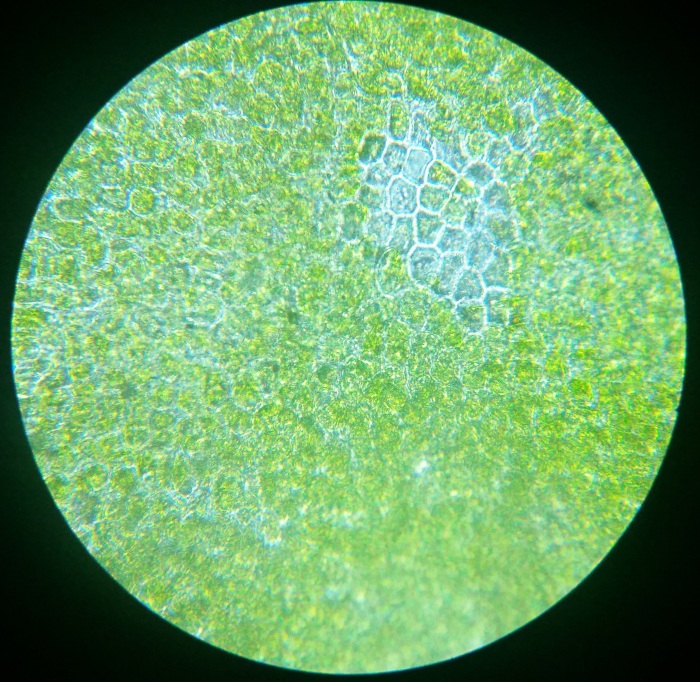
My wife and I live near a small public beach, a boat launch, and a pier by the Long Island Sound. We often take walks there and back. When we went the other night, the air was misty, perfectly still, and just the right temperature to walk in a t-shirt and only sweat a little after a few miles.
I had meant to take a test tube or two with me. I have these plastic ones with snap tops that are 1) cheap and 2) shatter proof. Nothing like having a sample loosed in your pocket with shattered glass.
However, I remained hopeful that I would find what I needed along the way. We walked past some wonderful musicians playing on their balcony, past the little pizza joint that is only open for tourists, and to the end of the dock. That’s where I saw it. A coffee cup, sitting on a bench. It was a bit wet from having sat there, but it looked like no one ever took even a sip. It was the paper kind with the snap on plastic top that includes the pre-cut hole (not the one where you have to break off the plastic and fold it back to where it never fits).
My wife was not as pleased as I was with my discovery of such useful garbage. I emptied it out, and it had no bugs or anything (success!). The tide water was higher than it had been in recent memory, so it was easy to kneel down, and scoop up some sea foam.
On my way back, I realized two things.
We walked to the boat launch, I emptied the foam, and rinsed the cup. It was dark there thanks to a broken street lamp, so my wife used her cell phone flashlight. Hundreds of sizable minnows swarmed to the light and darted all about. Part of me wanted to catch some, a problem of sorts I’ve had since I was a kid.
I shook off the desire, and finally saw a tiny green ribbon floating about 1 feet into the water. It took a few tries, but I finally got it in the cup, which by now had gone a bit soft with constant liquid. I almost squished it trying to put the top on.
Was it worth it? I’ll let the photos speak for themselves.
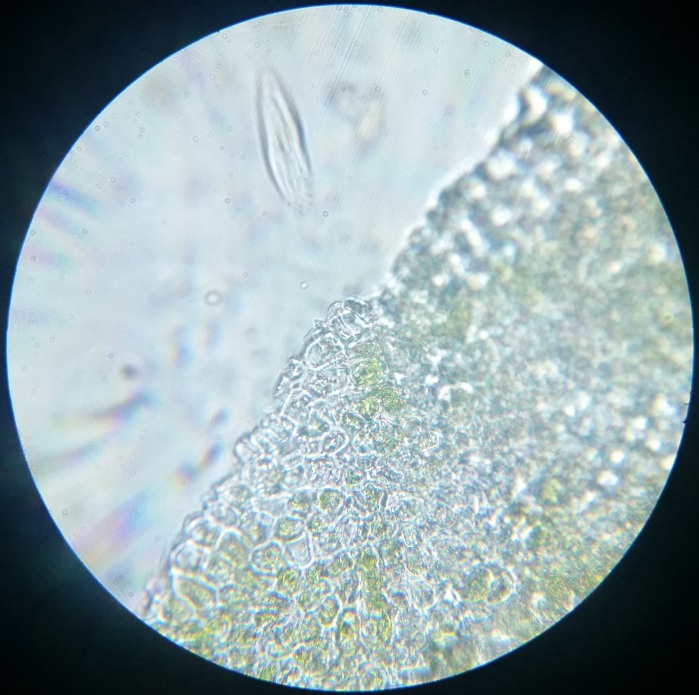
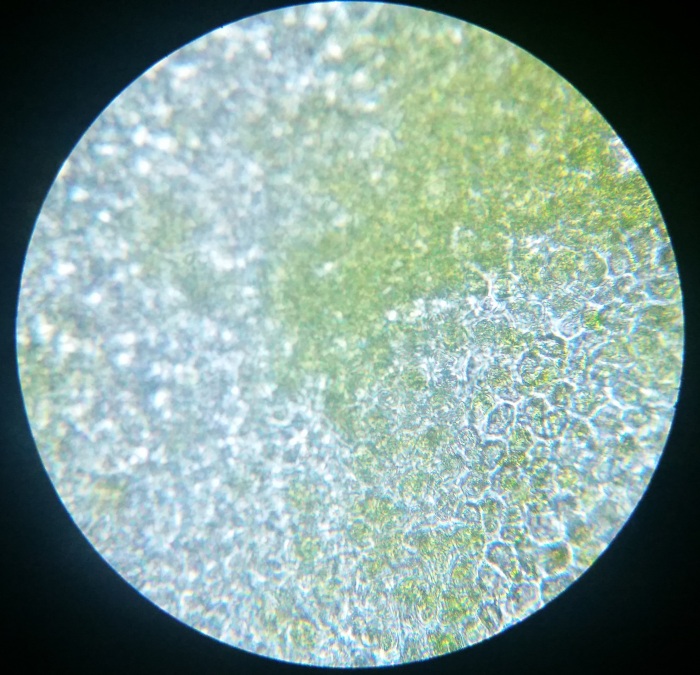
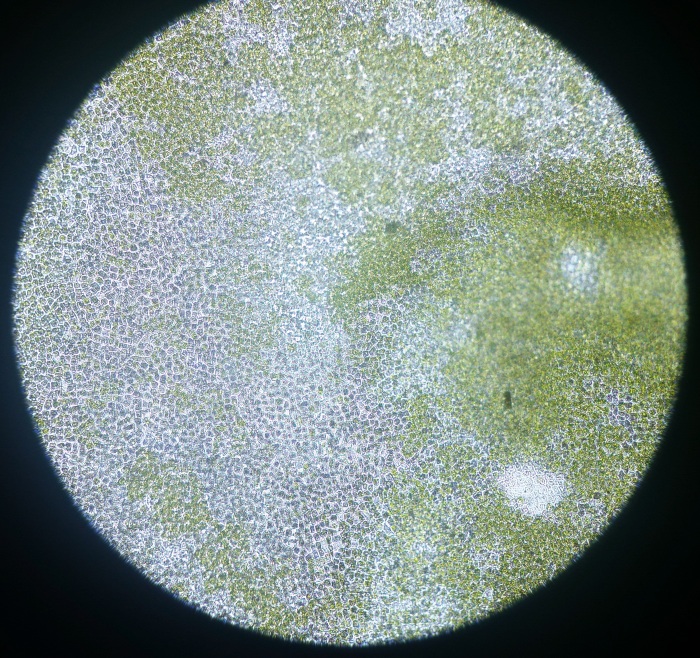
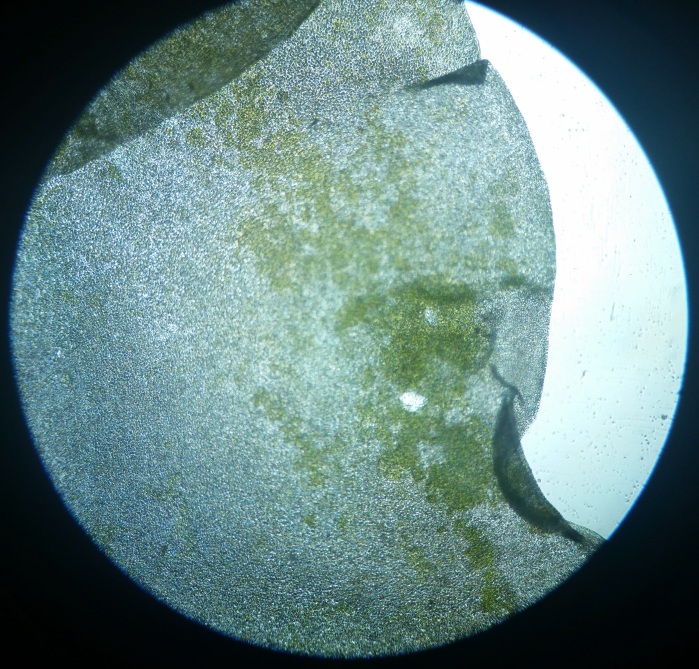
A few things to note. The edge shows how this strand is somewhat spiraled. As a result, despite being flattened with a cover-slip, part is almost always out of focus while part is in focus. This is where the seaweed retains it’s spiral shape, with part leaning towards the glass, and part away from it.
I’ve yet to find any plankton or other tiny critters, but I’ve only explored about 10% of the sample.
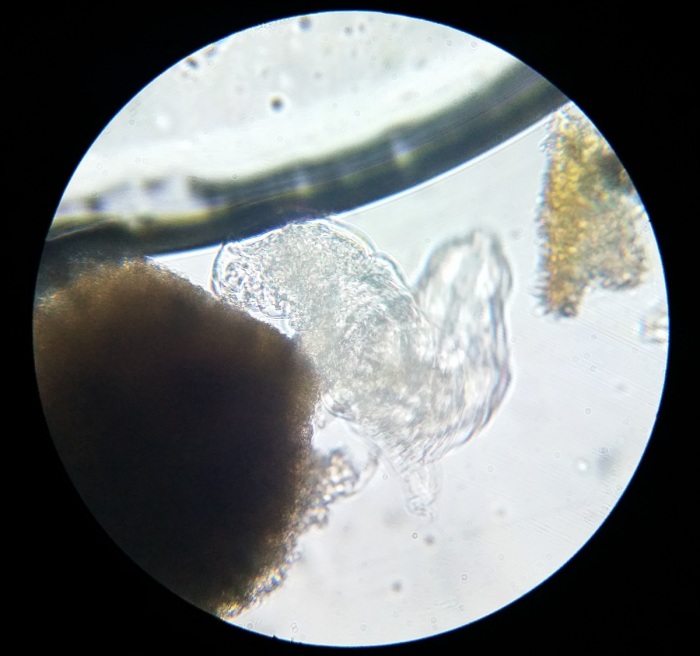
This is a triumphant picture that I took of a water bear. It’s like a tiny underwater caterpillar with a strange pointy mouth and eight caterpillar-like legs. I’ve always wanted to find one of these little guys, and I began my search before this last fall.
The more scientific name of the water bear is the tardigrade. They are remarkable creatures, capable of surviving in every extreme, from the crushing depths of the bottom of the ocean to the ravages of space. They can survive in boiling water and in sub-zero temperatures. In a heart beat they can go into a sugar based cocoon where they can live in stasis for up to 100 years.
The journey to find the water bear began with me being energetic enough to gather a wisp of moss. Every weekend I would walk, and intend to grab some, but then I would forget, or get to the car and remember and have too much ADHD to get back to woods that day. I would talk about how I was going to find one of these amazing creatures, and soon it was too cold to go into the woods.
But then the spring came, and I went on several hikes. On a recent one, I finally remembered what I wanted, and I grabbed a small tuft of dried moss off of a rock and brought it home.
I still procrastinated for a few days before I dropped it in wine glass (a very clean wine glass) and added some distilled water. This ensured that the water bears would hatch, but also that I wouldn’t add deadly chemicals (water treatment in the tap water) or foreign objects and organisms (from tap or ground water).
The project began four days later, when my deep well slides arrived, mostly smashed, in the mail. A few were good enough to use, and after some slick customer service work, I managed to get my money back.
I excitedly prepared a slide, awkwardly held my cell phone against the eye piece, and immediately found this:
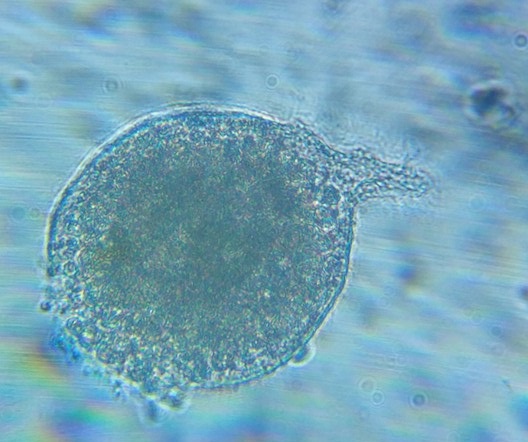
It’s a smooshed algae. You see, my microscope has been in a box for a long time, and I guess it took some glancing blows over time and it was in pieces. Last fall, when I wanted to start this, I glued it together, cleaned it up, and immediately made a mistake that I wouldn’t understand for a while (involving a piece interfering with the finer adjustment. As a result, I zoomed in too much with the 400x magnification, and the lens popped this little guy.
You can see his guts exploding out the right, and a little bit on the left. It’s still awesome though. That’s chlorophyll on the inside, that amazing photosynthesis producing material that plants use to harmlessly take energy from the sun (smug bastards).
I also found this:
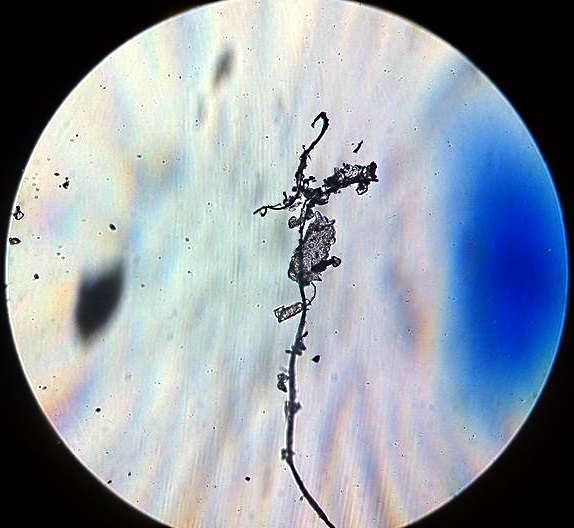
I was still improving on my camera technique, but I still captured this interesting little plant thing. Not sure what it is, but that clear sausage in the middle is a dead rotifer. They are nifty little fat, larva like critters, and for some reason, they are mostly dead in my sample water.
I took a break until the next day (feeling somewhat defeated, a common theme with ADHD). Then I found this the next day:
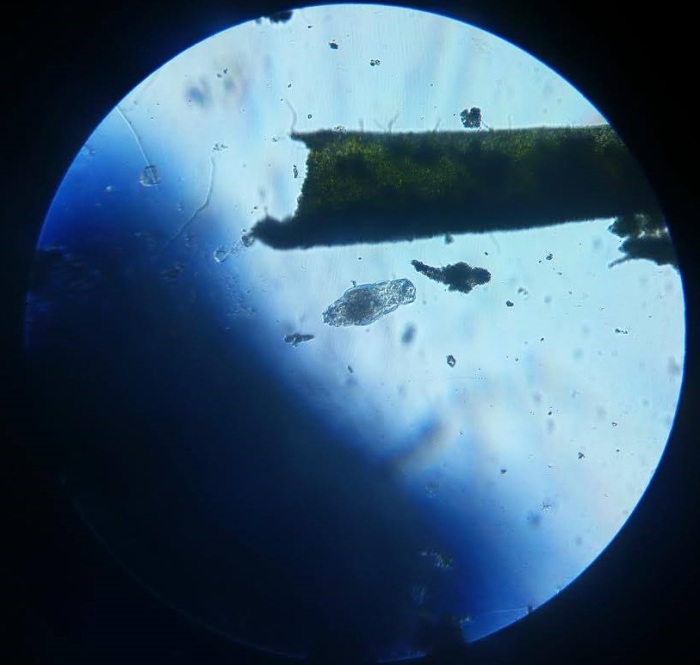
I thought, yes, that could be it! I did some math to be sure, it was 100x, and water bears are about 30mm long, and I concluded that this object was just under that. It even had a little hole that looks a lot like their mouths. But, I’m wrong. That’s its butt, and it’s a rotifer. And it’s dead.
I had begun to wonder if I was ever going to find a water bear. These images were the result of an hour of searching. And then the next day, I hit pay-dirt. You’ve seen the image above. Here are two more images.
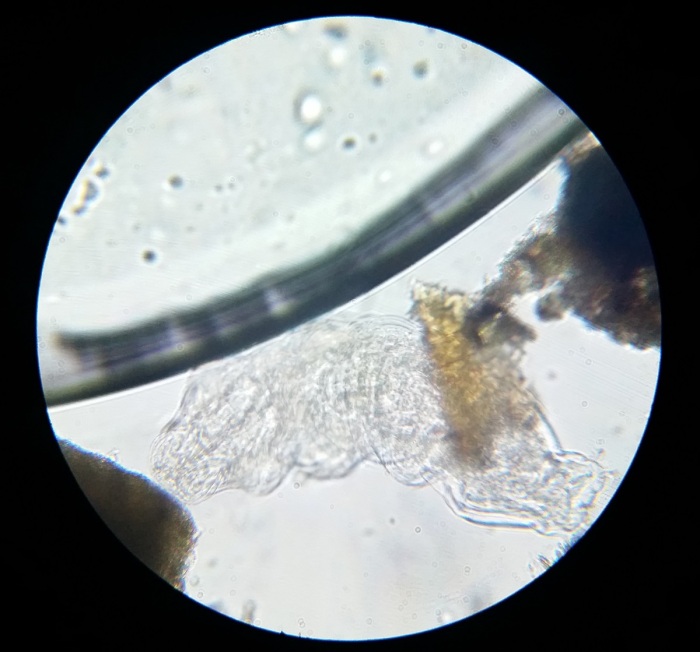
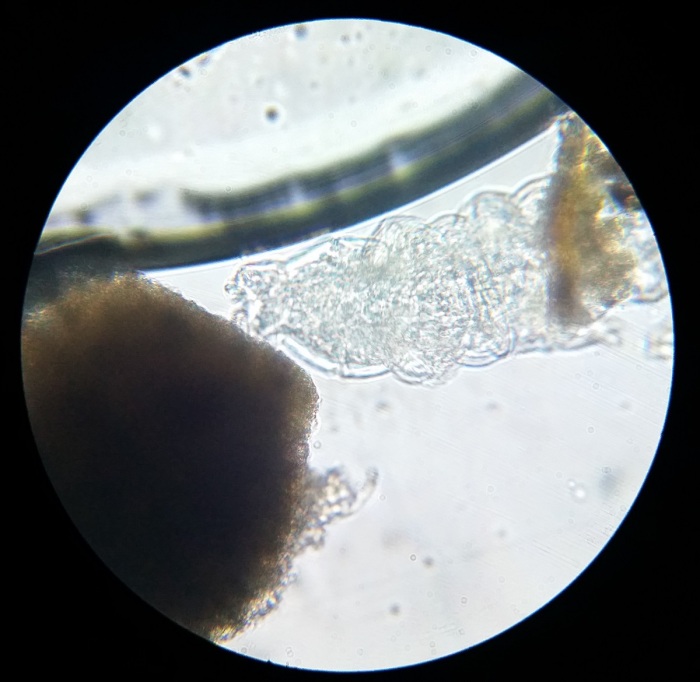
I had to download a different app for my phone in order to get the focus right, and after a few snaps, I did what I really wanted to do. I got three 100x videos of them, and then three 400x videos. I also experimented with different LED back lighting.
Here are the three closeup videos (400x), so you can see them in action:
Hopefully you found these strange little critters to be as interesting as I did. You can find out all about them with a google search, or on Wikipedia.